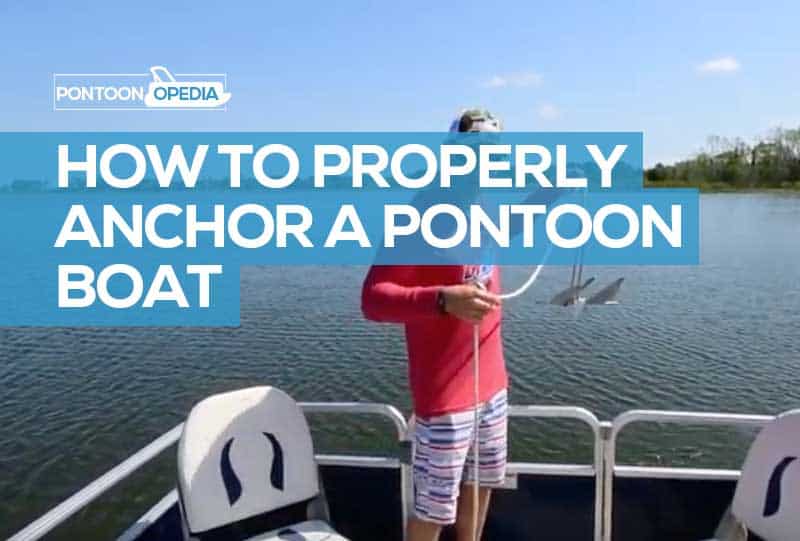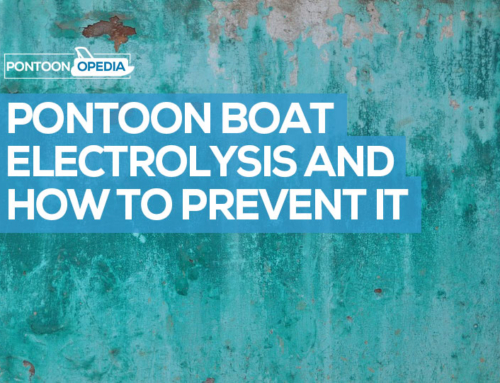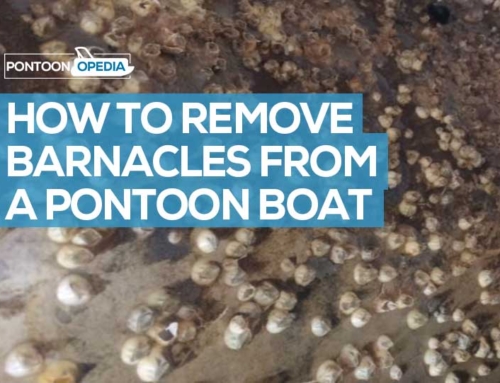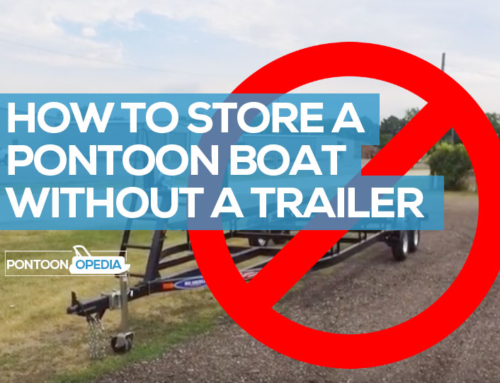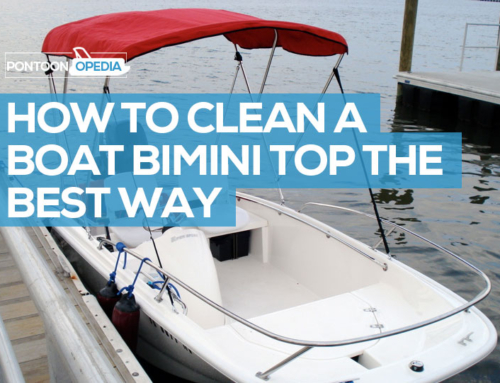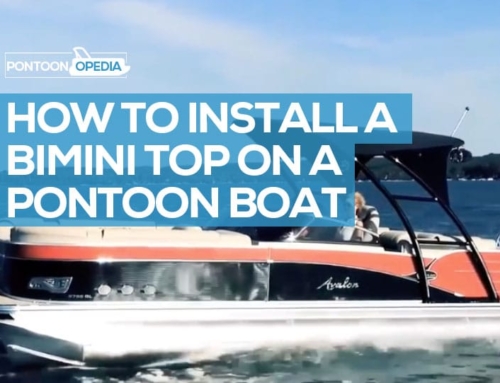Pontoon boating is easy, it honestly is. If you can drive a car, I believe you can drive a boat. But there is one small aspect that isn’t so easy to master; anchoring. In this short guide I will tell you how to properly anchor a pontoon boat, using the tips I’ve picked up over the last few years.
To anchor a pontoon boat properly, need to calculate the depth and get your boat into position properly. Then lower the anchor off of the boat’s bow and let it get hooked onto the bottom of the lake or river. Use a visual landmark to check for drifting.
So that’s a very quick answer, there are a lot of intricate steps involved which I am going to take you step by step through now.
How to anchor a pontoon boat in 7 steps
Pontoon boats are very buoyant and can bounce around a lot. It’s essential skill to be able to anchor them properly.
For instance, the lowering of your anchor itself needs to be done in a certain way with the appropriate amount of slack in the rope.
To keep your boat from drifting, I have included a guide that is in-depth for any beginner or seasoned boater. These steps will help to keep your experience enjoyable and far from the rocks.
There’s been a time or two where I got a bit too close, all because I didn’t pay attention to the way that I was anchoring my boat. You can learn from my mistakes below.
Before you read the guide, watch this quick video tutorial on how to anchor a pontoon boat from a boat rental company (Winter Haven Water Sports).
1. Positioning of your pontoon boat
The first step in anchoring is to decide where you want to settle.
Ideally, this would be away from any banks or rocks where you could put both you, your passengers, and boat at risk.
You should also consider the wind; pontoon boats are very susceptible to being affected by these factors.
If your day out on the water is calm with just a little breeze, you don’t need to worry so much about which way your pontoon boat is facing.
If you are in a strong wind or current, you should face the nose of the boat in the direction of the strongest of the two.
If the current is stronger towards the North, angle your boat so that the nose is tipped in that direction. This will save you a big struggle in the long run.
2. Calculating rode
Once your pontoon boat is faced in the correct position, you need to check depth of the water.
The type of material on the bottom will also play into how much rode you will need in order to successfully anchor.
The Boat US website has laid out a guide for those unsure about the amount of rode needed in certain depths. A depth finder can also help in this step.
Once you have a good idea on the water depth, measure out five times as much rode length as that of the water depth. This will ensure that you have enough to play with securely when anchoring.
3. Prepare to anchor
After making all of the necessary calculations, it is time to properly anchor your pontoon boat.
To successfully anchor your pontoon, you need to make sure that the boat is mostly as static and still as possible.
You can help achieve this by placing the engine in idle. I also recommend placing the bow slightly forward in terms of where you want to anchor.
4. Drop the anchor
Now when I say “drop”, don’t actually plunk it into the water.
You may be tempted to throw it into the water, but this may be dangerous for you and your fellow boaters.
When you lower the anchor into the water, you don’t want it to become tangled with the line.
The length of the anchor released should be equivalent to about five to seven times the length of the depth of the water.
Before gently lowering the anchor, you should make sure it’s secured to your boat.
I’ve heard of horror stories of fishermen losing this hefty piece simply because they did not tie it down, and also getting pulled into the water.
To properly anchor your pontoon boat, make sure you secure it first. Do this by tying the anchor to the cleat. Do this twice for a better hold.
Also, keep in mind that your boat may begin drifting backward. This is not unusual as pontoon boats can be affected by the wind or currents when strong enough.
5. Feel for resistance
In order for an anchor to be dig in properly, it needs to be on the bottom of the lake or river.
It needs to dig in securely, as this will reduce the chances of your boat.
You might have heard the expression, “dragging the anchor”. This is crucial in keeping your boat still and you need to avoid this.
The best way to tell if your anchor is secured into the bottom is to wait a little. This might sound a bit tedious, but it’s helped me in my own boating trips.
After letting the anchor slip into the water and make its way to the bottom, you simply let the boat move with the current.
If you put your pontoon boat in the right position, then this will be backward. Let this happen until it stops moving altogether.
Once your pontoon boat has stopped drifting backward, I still recommend taking some extra precautions; triple check your anchor system, put your engine in reverse.
Slowly and steadily move the boat backward. This will pull on the anchor.
If your anchor does not seem to hold, try again. There is no harm in needing to let down your anchor multiple times.
I’d rather take the time to fix this than end up on the rocks.
6. Use a landmark as a visual indicator
The best trick that I’ve used down the years is to take note of the landmarks around you. If unobservant, you can fail to realize how much closer you’ve gotten to the shallow region.
The best advice is to check on these markers from time to time.
For example, I’ll find a tree on the land and take note of what its parallel to, perhaps to a Bimini frame leg.
If the tree has moved in its relative proximity, I revaluate how far I’ve drifted and might then anchor my pontoon boat down again.
7. Up again
Now I know that this final step isn’t how to anchor your pontoon boat, but it is equally important to know when to pull the anchor up again.
The best fishermen and recreational boater know when to let down their anchor and when to pull it up again when needed.
Just as with anchoring, there are precautions that one must take.
To avoid damaging your pontoon boat, the best way to get your anchor out of the water is to gently pull up at a vertical angle, if you can.
You don’t want to scratch your boat or puncture your aluminum pontoons.
Another good habit to get into is to wash off any mud or debris that could potentially bring invasive species or problems onto your boat.
Now that you are fully aware of how an experienced boater gently drops an anchor off of a pontoon boat, you may have more questions.
Related questions about pontoon anchoring
Below you can read through some of the extensive question and answer articles I have previously compiled on Pontoonopedia if you want to explore more topics.
What if my pontoon is still drifting?
Even experienced pontooners will still experience drift. Strong wind and currents have a major impact on this.
You may want to invest in an additional anchor that can be dropped off of the side.
Where to tie anchor on a pontoon boat?
One of the most popular anchor articles on Pontoonopedia was published originally in 2018, and tells you the best location to fit your anchor.
How to anchor a pontoon boat onto a sandbar or beach
Beaches and sand are tricky to anchor into and come with their own unique set of challenges. You can read two guides I have separately written which address both situations.
What is the best pontoon boat anchor winch?
I was diagnosed with back problems a few years ago. Since then I’ve looked for any ways in which I can make my pontoon days easier and more enjoyable.
Using an anchor winch has made my job so much easier (see which one I recommend). It takes a lot the hassle away, letting me pull my anchor back up without putting more strain on my back.
Are there any anchor mounts and ledges you recommend?
If you aren’t familiar with ledges and mounts, they attach to your pontoon boat, so you don’t have to have the winch on your deck. Here are some great anchor ledges.
I bought a ledge and it’s freed up some space for me and means my kids don’t trip over and hurt themselves. If you have a small pontoon boat, a winch mount or ledge will be an essential purchase.
There are also some anchor winch mounts in this guide.
What is the best river anchor for a pontoon boat?
I prefer to have anchors to suit all different scenarios. When we tow our pontoon to a river, I get take a large slide box anchor with me.
You can read more about river anchors, with a recommendation for the best one to grip into muddy and sandy riverbanks.
Is there a universal anchor that will suit all bottom types?
I’m glad you asked, because there is, but I do personally prefer a specialist anchor depending on where I am going to be boating.
I’ve developed a guide to the best pontoon boat anchors which details the best in each category and why they suit certain bottom types.
The last word…
When you hear the word “pontoon boat”, what do you think of?
Is it the boat of a dedicated fisherman? Or is it the family boat used for water skiing?
Pontoon boats are really safe, comfortable, and above all, versatile.
However, you will need a decent anchor to keep your boat from moving around whilst you want to stay stationary. You can find which ones I recommend in the questions above.
I hope that this has given you all the information you need in order learn how to properly anchor a pontoon boat – good luck!

